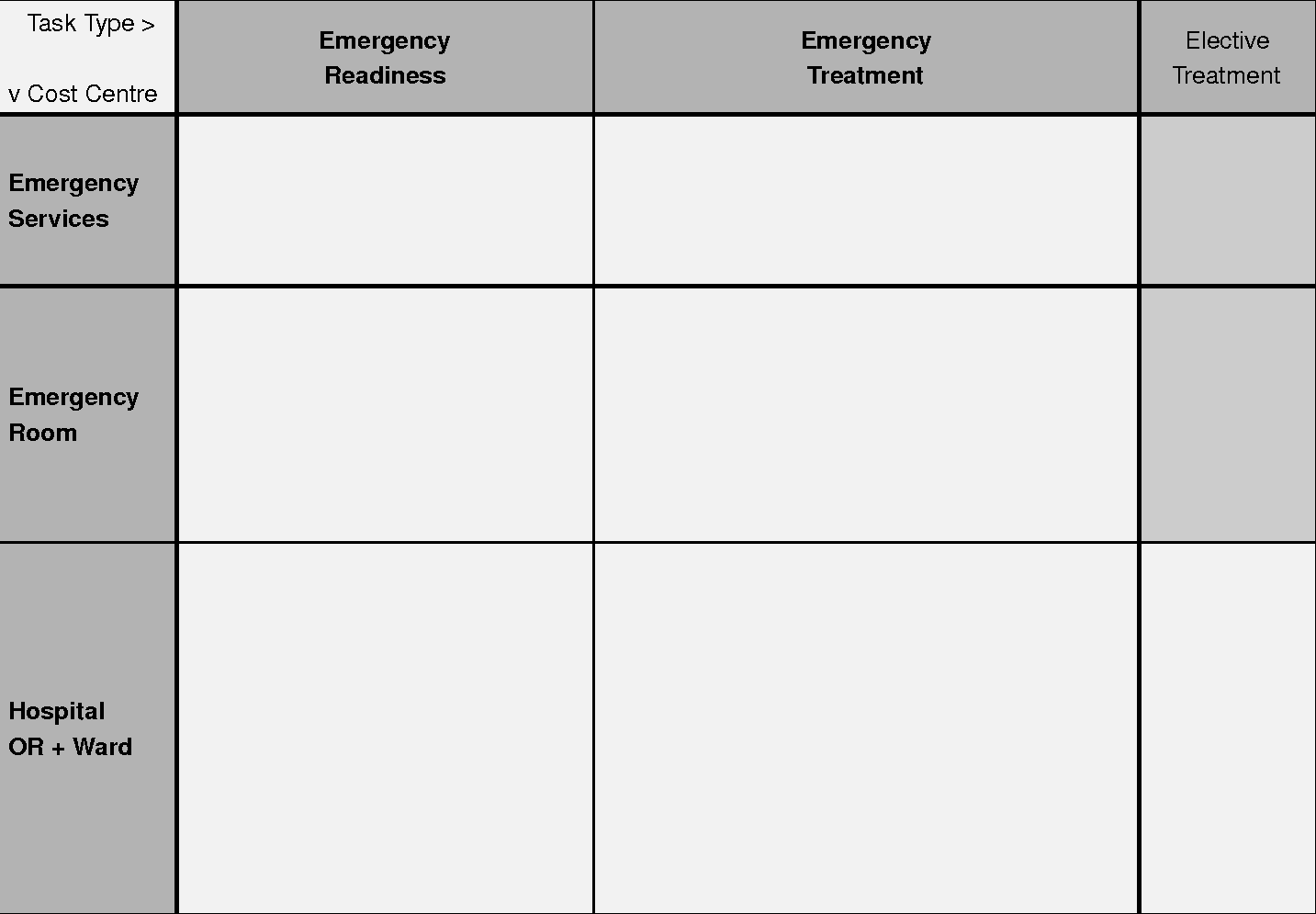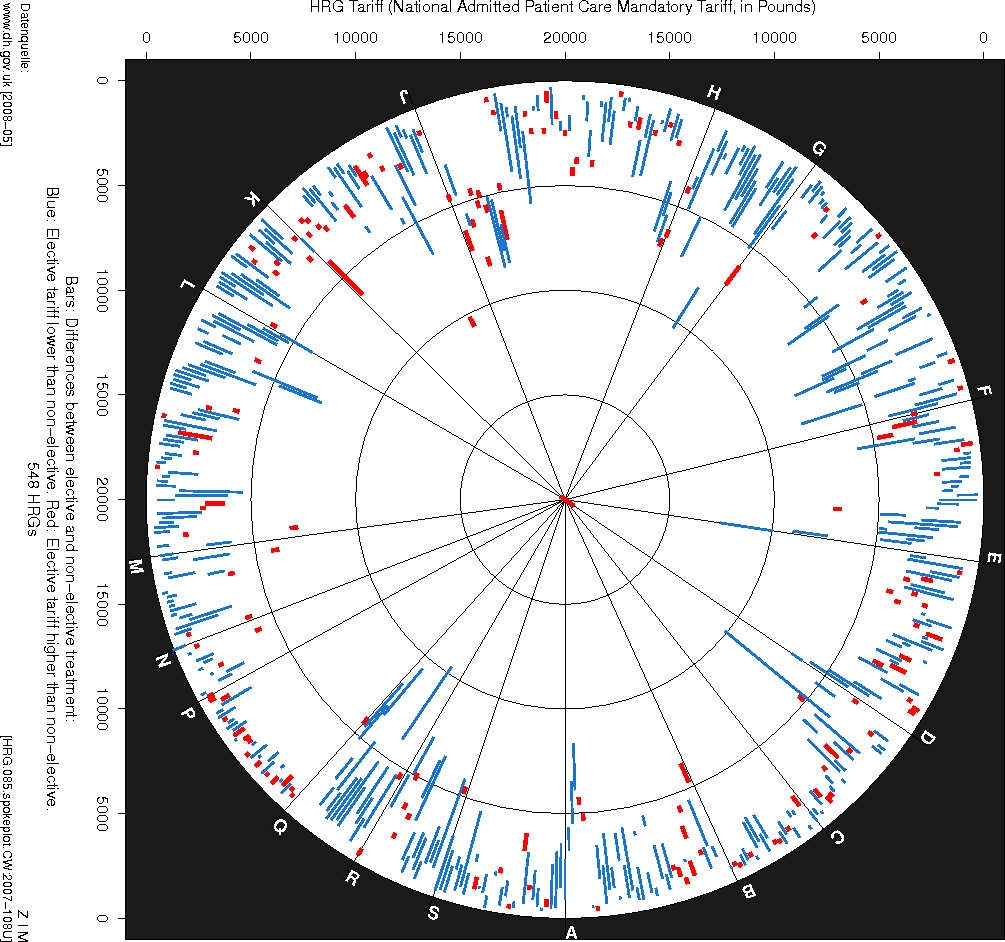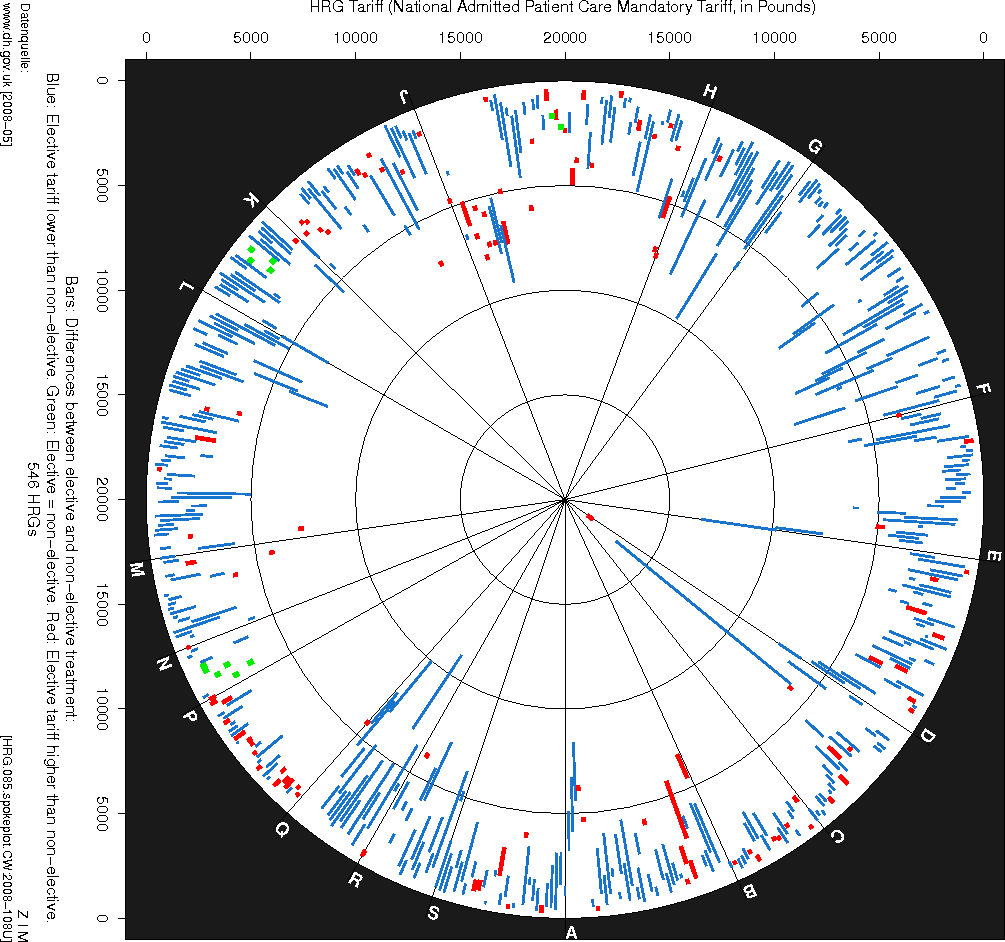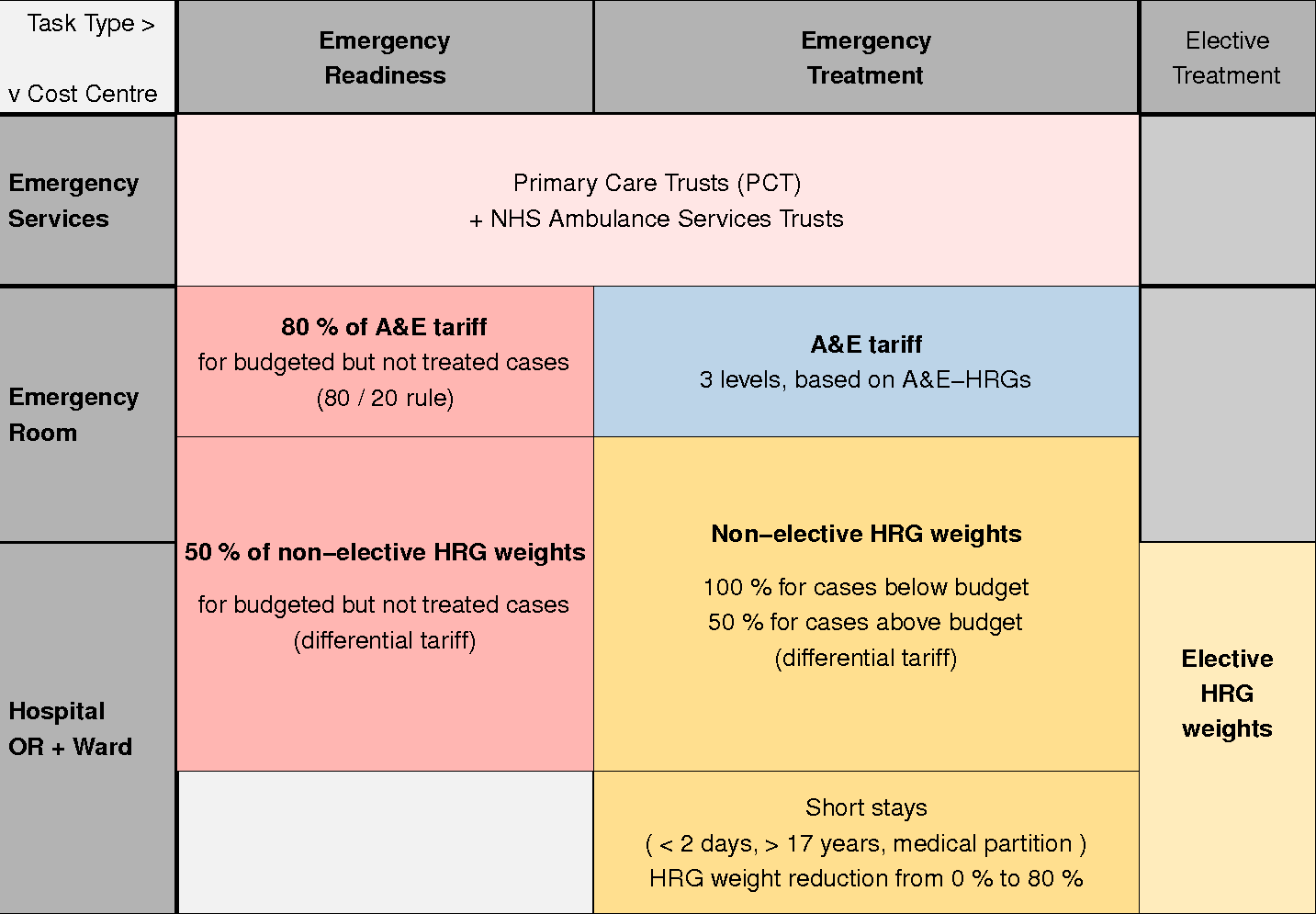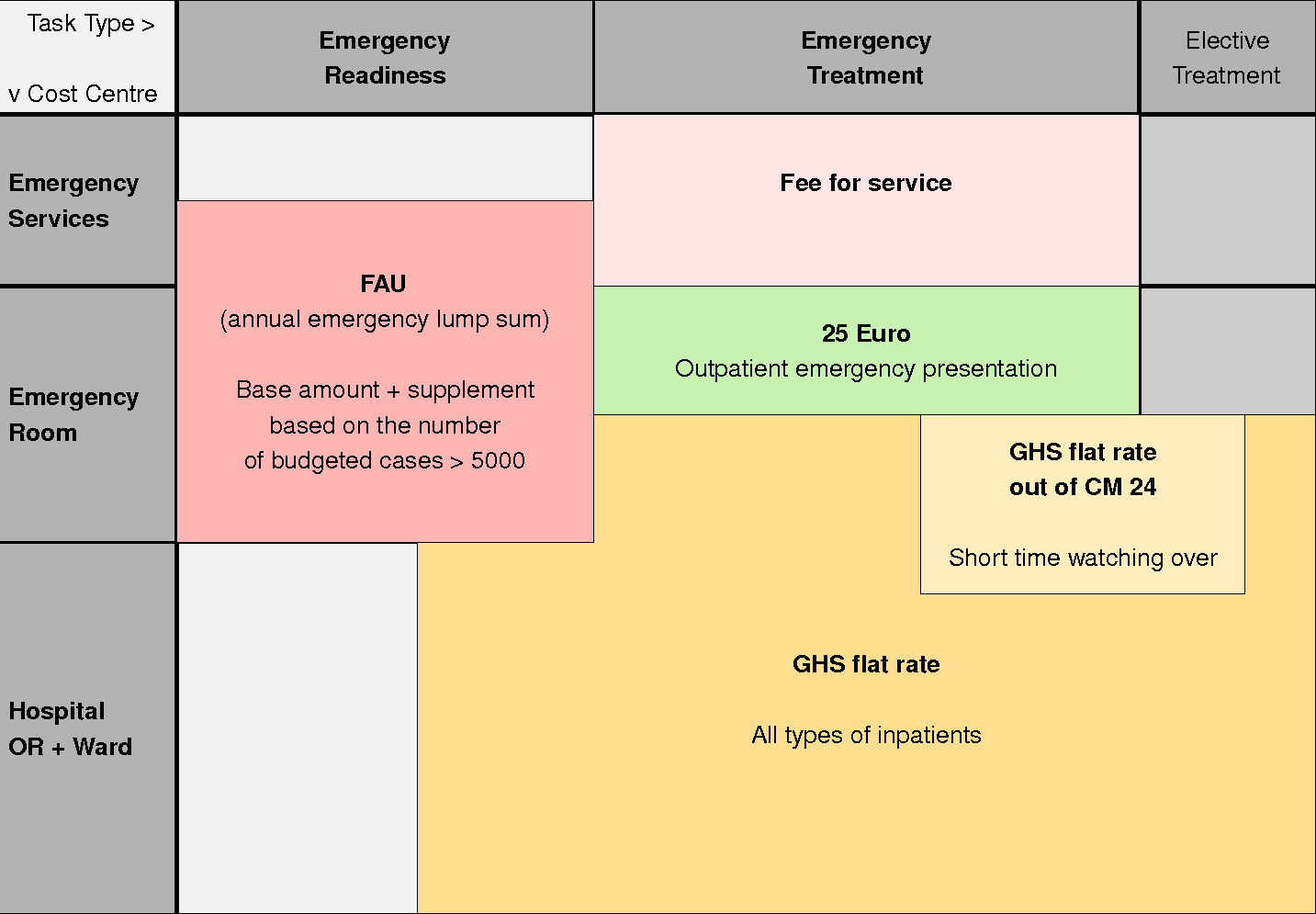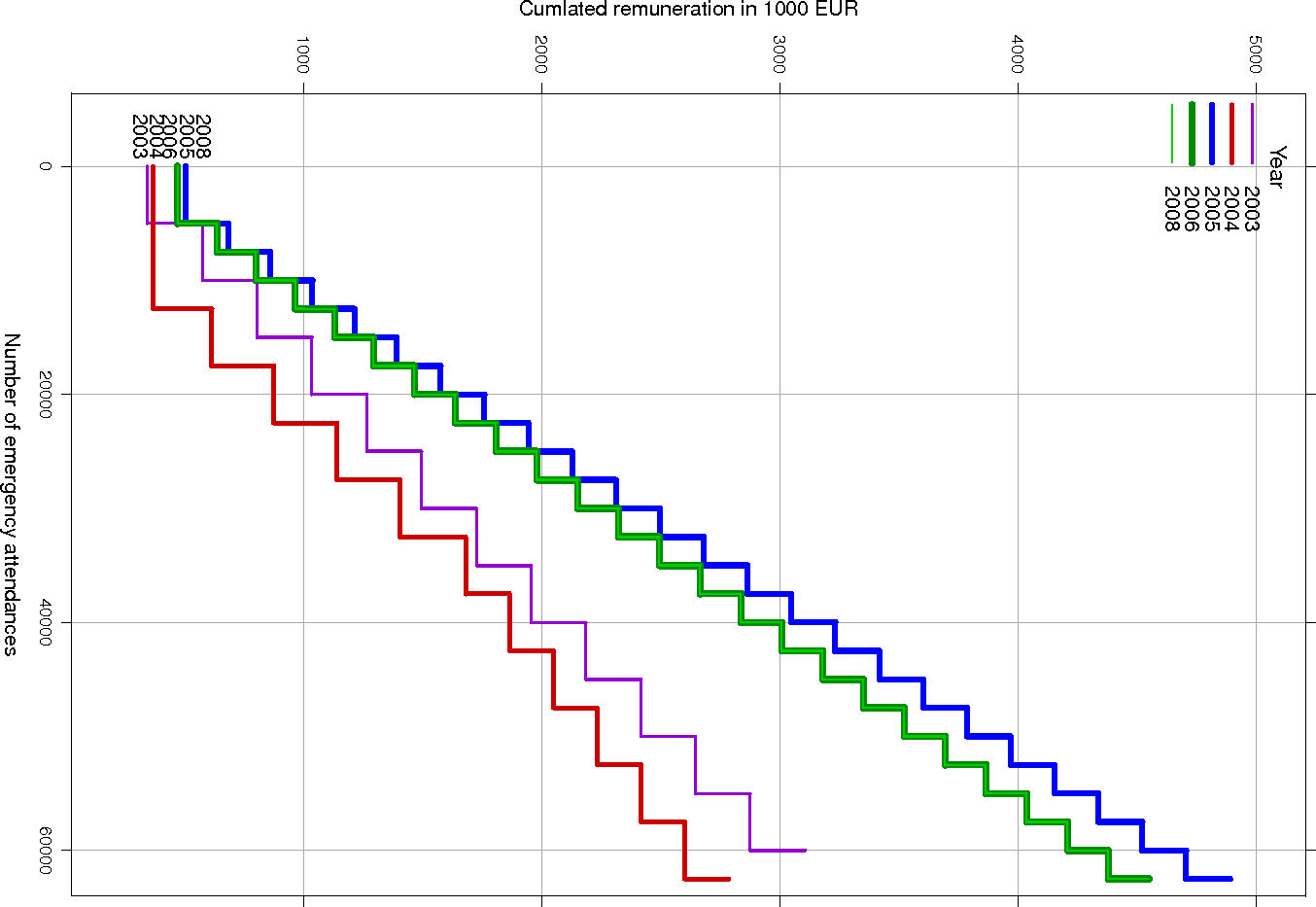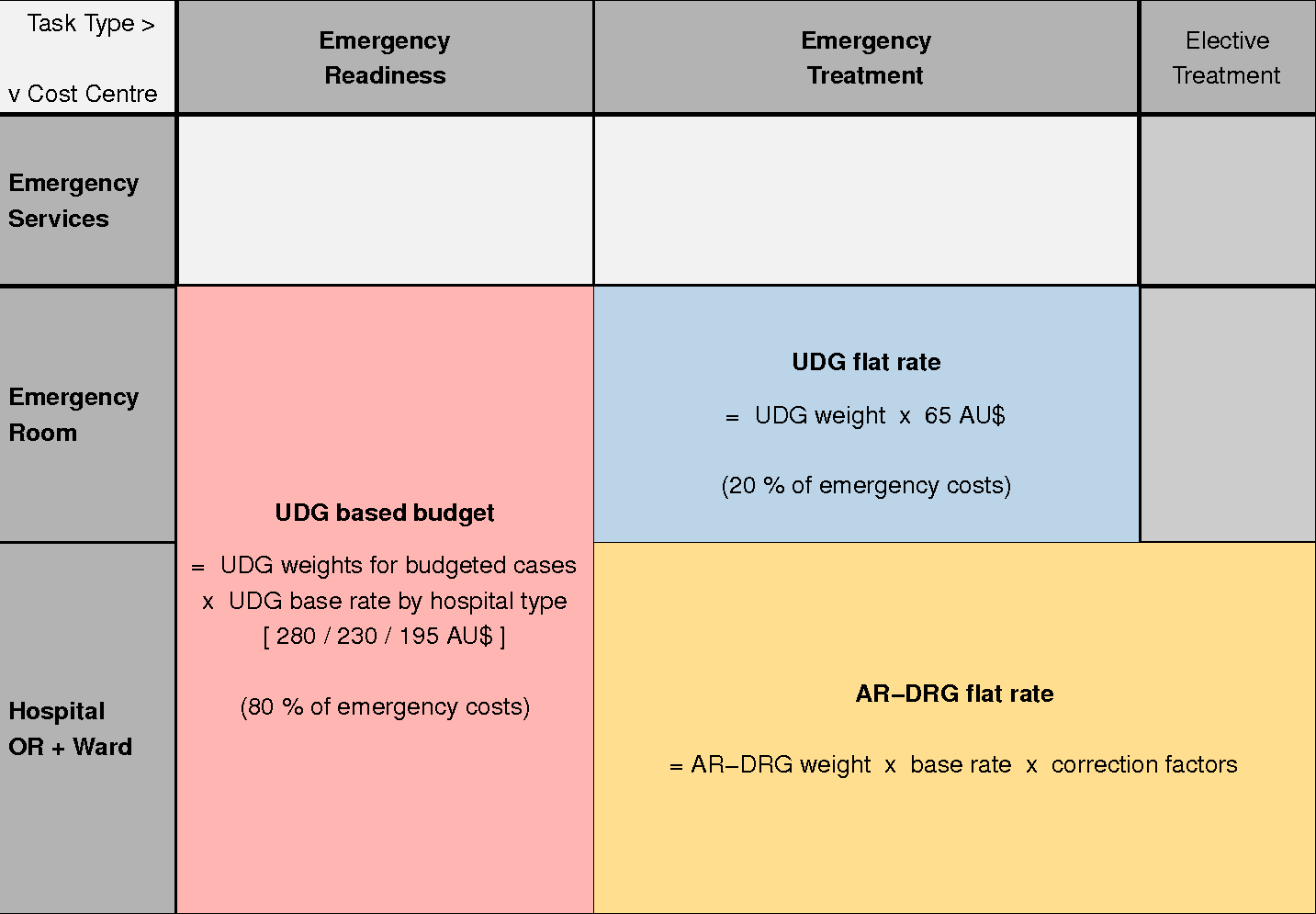|^·<×>·v| |
1 |
Introduction
|
|
Introduction |
Flat rates based on Diagnosis Related Groups (DRGs) are being introduced
in a growing number of countries
to remunerate acute inpatient treatment.
In doing so, it will have to be decided – among other things –
whether inpatient emergency services should be remunerated
separately from the DRG flat rates or as part of them.
Without separate remuneration,
there may be an apprehension
that wrong economic incentives
with regard to emergency services
could develop.
To be able to decide
about a separate remuneration of emergency readiness
and/or emergency treatment
one must know
how to categorise services,
what are the costs of emergencies
and how the remuneration can be deduced from them. |
1
Fischer [Notfallvergütung im Krankenhaus, 2009].
|
Study for DKG |
The presented material was collected for a study
for the German Hospital Association DKG (Deutsche Krankenhausgesellschaft).
Later it was published as a book of its one.1 |
|
|
|
|^·<×>·v| |
2 |
Methods
|
Table 1:
Emergency Remuneration Scheme
|
|
|
|
[Table 1]
Inpatient urgency remuneration systems of different countries
were analysed using a scheme developed by combining
aspects of cost calculation and tasks to perform. |
|
|
|
|
Aspect (1) |
Costs and cost centres:
- Emergency services.
- Emergency room.
- Further hospital services.
|
|
–
Emergency services |
Emergency services include
the emergency telephone number,
the emergency physicians,
the ambulances,
etc.
They encompass the activities for the patient
outside the hospital. |
|
–
Emergency room |
Emergency room include
emergency beds with 24 hour access,
experienced emergency nurses,
physicians which are available within short time, |
|
–
Hospital services |
The further hospital services include
hospital operations rooms and wards.
There must be availablity of treatment
which can be urgently planned and performed.
There has to be skilled personal, free rooms, and adequate equiment. |
|
|
|
|
Aspect (2) |
Tasks:
- Emergency readiness.
- Emergency treatment.
|
|
|
|
|
Internet searches (2008) |
By means of internet searches in the year 2008,
the author collected information about different solutions
of emergency patient classification systems
and emergency flat rates
in France,
United Kingdom,
New South Wales (Australia),
and – additionally – about
various approaches towards regulations in
Switzerland,
Germany,
United States,
Canada,
and Victoria (Australia). |
|
Aim: Suggestions |
The information was collected with the aim to be able
to suggest – with a view to deciding
about the design of inpatient urgency remuneration systems –
whether any increased emergency costs
would justify separate remuneration and how this could be set up. |
|
|
|
|^·<×>·v| |
3 |
Results: Inpatient emergency remuneration in selected countries
|
|^·<×>·v| |
3.1 |
Switzerland (SwissDRGs planned for 2012)
|
Table 2:
Emergency Remuneration in Switzerland
|
|
|
Separate remuneration of public welfare services |
In Switzerland, acute inpatient treatment will be remunerated
from 2012 onward
by the SwissDRG-System, an adapted GDRG-System.
Following a law introduced at the end of 2007,
the new flat rates must not contain public welfare services.
Hence, emergency readiness has to be calculated and remunerated
separately from DRG flat rates, independently of the number of cases. |
2
GDK-CH [Leitfaden Spitalplanung, 2005]: 55.
|
Number of inhabitants |
There is a recommendation that remuneration for emergency readiness
should be derived from the number of inhabitants.2 |
3
BFS-CH [Medizinische Statistik, 2005]: 33.
|
Definition of "emergency" |
In the Swiss minimal data set,
"emergency attendances" are defined
as attendances of patients who are
"required to be treated within 12 hours".
As complement, "planned admission" can be chosen.3 |
|
|
|
|^·<×>·v| |
3.2 |
Germany (GDRGs)
|
|
50 € DRG tariff deduction per case |
In Germany,
there is no separate remuneration for emergency admissions.
In principle, hospitals are ordered to participate in emergency services.
Hospitals which do not participate have to
expect a deduction of € 50 per case. |
4
DKG [MDS § 301, 2007]: 13+65.
|
Definition of "emergency" |
Emergency attendances can be coded in the German minimal data set,
but no definition is given.4 |
|
|
|
|^·<×>·v| |
3.3 |
United Kingdom (HRGs)
|
Table 3:
HRG 3.5: Differences of HRG tariffs 2007+ for elective and non-elective treatment
|
|
Table 4:
HRG 3.5: Differences of HRG tariffs 2008+ for elective and non-elective treatment
|
|
5
http:// www.datadictionary.nhs.uk / data _ dictionary / attributes / a / add / admission _ method _ de.asp
[2008-4].
An admission is an "emergency admission",
when "it is unpredictable
and at short notice because of clinical need".
|
Elective and non-elective admission |
In the british minimal data set for acute inpatient treatments,
a distinction is made
between elective and non-elective admission.
Non-elective admissions encompass urgent admissions as well as
maternity admissions, newborns, and transfers.5 |
6
DH-UK [Tariff Calculation, 2008].
DH-UK [PbR Guidance, 2007].
DH-UK [PbR 2008+, 2007].
|
Differences within many HRGs |
When calculating treatment costs,
differences between treatment with elective and non-elective admission
where found within many HRGs.6 |
7
Fischer [Neue Grafiken I, 2010]: 15 ff.
|
Spoke plot |
[Tables 3
and 4
]
I drew these differences of tariffs of all HRGs by means of
a "spoke plot".
A spoke plot is a kind of a bar chart.
As base line, a circle line is used instead of a straight line.
A spoke plot occupies only a third of the space
of a conventional bar chart.7 |
|
|
The difference bar for each HRG is put
on a imagined line starting at the circle base line
going to the centre of the circle: this is the spoke line.
The HRGs are grouped according to the HRG main categories (= MDCs).
These are abbreviated by the letters shown at the circle border
at the beginning of each MDC sector.
The scale from the circle line to the centre shows
the HRG tariffs (in english Pounds). |
|
|
The coloured lines show the differences between the HRG tariff
for non-elective and for elective admission.
If the non-elective tariff is higher than the elective tariff
the differences line is blue, else it is red.
A green point shows that both tariffs have the same value. |
|
|
It can be seen that most HRGs have blue lines
i. e. higher tariffs for non-elective
treatment than for elective treatment.
Some of these differencies are very big.
And they grewed from 2007 to 2008.
But there are also some elective tariffs which are
higher than non-elective tariffs (the red coloured differences).
By comparing the two graphics,
one can see that the some differences changed remarkably from 2007 to 2008. |
8
http:// www.hesonline.nhs.uk /
> Accessing the data > Freely available data > Inpatients > Healthcare Resource Groups
.
[2008-11]
|
Estimated redistribution:
9 % to 10 % |
I tried to estimate the redistributed sums.
I calculated an averaged tariff for each HRG
by weighting the two HRG tariffs with the number of urgent
respectively elective cases as found in the "Hospital Episode Statistics".8
The estimated redistribution amounts to 9 % to 10 % of the
total remuneration volume. |
|
|
[Tables 5
and 6
]
I listed HRGs with huge differences in two tables.
One table shows HRGs with higher tariffs for non-elective treatment,
the other shows HRGs with higher tariffs for elective treatment. |
Table 5:
HRGs with huge absolute or percent differences of tariffs
2008
for non-elective admissions compared to elective admission
with expected length of stay ≥ 3 days |
| HRG
| Label
| Cases 2006
| %urgent
| Tariff £ el./non-elect.
| % Diff.
| ELOS el./non.
|
| A11
| Muscular Disorders
| 2600
| 33 %
| 1100 / 3900
| +260 %
| 7 / 40
|
| C54
| Complex Major Mouth or Throat Procedures
| 1400
| 6 %
| 6100 / 17000
| +170 %
| 48 / 114
|
| F45
| General Abdominal - Diagnostic Procedures
| 9300
| 61 %
| 760 / 2900
| +280 %
| 7 / 32
|
| G04
| Liver - Major Procedures>69 or w cc
| 4100
| 27 %
| 1100 / 4900
| +330 %
| 5 / 48
|
| G11
| Biliary Tract - Complex Procedures
| 550
| 15 %
| 6200 / 9800
| +57 %
| 24 / 54
|
| G16
| Diagnostic Pancreatic or Biliary Procedures w cc
| 1000
| 43 %
| 1200 / 4600
| +280 %
| 5 / 40
|
| G22
| Pancreas - Very Major Procedures
| 1600
| 15 %
| 4300 / 8100
| +90 %
| 36 / 64
|
| H16
| Soft Tissue or Other Bone Procedures - Category 1>69 or w cc
| 10000
| 15 %
| 1500 / 4800
| +220 %
| 5 / 47
|
| H53
| Pathological Fractures or Malignancy of Bone and Connective Tissue>69 or w cc
| 10000
| 55 %
| 860 / 3800
| +350 %
| 10 / 47
|
| J21
| Other Burn with 1 Significant Graft Procedure>18 <50
| 550
| 59 %
| 1600 / 5300
| +240 %
| 7 / 28
|
| K15
| Diabetes and Other Hyperglycaemic Disorder>69 or w cc
| 5900
| 85 %
| 480 / 2200
| +350 %
| 5 / 24
|
| K18
| Non Pituaritary Endocrine Neoplasms>69 or w cc
| 1700
| 30 %
| 930 / 3400
| +260 %
| 7 / 38
|
| L05
| Kidney Intermediate Endoscopic Procedure>69 or w cc
| 4300
| 30 %
| 1200 / 4300
| +260 %
| 5 / 40
|
| L46
| Renal Replacement Associated Procedures
| 7500
| 15 %
| 1600 / 4900
| +220 %
| 3 / 41
|
| Q12
| Therapeutic Endovascular Procedures
| 20000
| 15 %
| 890 / 3700
| +320 %
| 3 / 36
|
| Q13
| Diagnostic Radiology - Arteries or Lymphatics w cc
| 3600
| 32 %
| 1300 / 4700
| +260 %
| 5 / 44
|
| Q15
| Amputations
| 5100
| 53 %
| 6900 / 11000
| +60 %
| 67 / 112
|
| Q16
| Foot Procedures for Diabetes or Arterial Disease, and Procedures to Amputation Stumps
| 2200
| 43 %
| 1000 / 4900
| +390 %
| 13 / 43
|
| Q19
| Vascular Access for Renal Replacement Therapy
| 9800
| 26 %
| 1700 / 6300
| +260 %
| 7 / 59
|
|
Table 6:
HRGs with huge absolute oder percent differences of tariffs
2008
for elective admissions compared to non-elective admission
with expected length of stay ≥ 3 days |
| HRG
| Label
| Cases 2006
| %urgent
| Tariff £ el./non-elect.
| % Diff.
| ELOS el./non.
|
| A30
| Epilepsy <70 w/o cc
| 29000
| 91 %
| 1700 / 950
| -43 %
| 11 / 7
|
| A31
| Head Injury with Brain Injury
| 8000
| 83 %
| 5600 / 2900
| -48 %
| 77 / 26
|
| A99
| Complex Elderly with a Nervous System Primary Diagnosis
| 24000
| 86 %
| 6600 / 5600
| -16 %
| 132 / 89
|
| C27
| Major Medical, Head, Neck or Ear Diagnoses w/o cc
| 7200
| 93 %
| 1300 / 950
| -28 %
| 10 / 7
|
| C35
| Major Maxillo-facial/ENT Procedures
| 3900
| 10 %
| 2700 / 2000
| -24 %
| 6 / 8
|
| D34
| Other Respiratory Diagnoses <70 w/o cc
| 23000
| 91 %
| 1200 / 810
| -32 %
| 7 / 5
|
| H19
| Soft Tissue or Other Bone Procedures - Category 2 <70 w/o cc
| 48000
| 40 %
| 1900 / 1600
| -16 %
| 5 / 3
|
| H36
| Closed Pelvis or Lower Limb Fractures>69 or w cc
| 23000
| 88 %
| 4900 / 4300
| -13 %
| 79 / 51
|
| H40
| Closed Upper Limb Fractures or Dislocations <70 w/o cc
| 32000
| 81 %
| 1800 / 1500
| -16 %
| 5 / 3
|
| H71
| Revisional Procedures to Hips
| 14000
| 46 %
| 7400 / 6500
| -13 %
| 27 / 45
|
| H88
| Other Neck of Femur Fracture w cc
| 6600
| 61 %
| 6100 / 5100
| -17 %
| 90 / 77
|
| L33
| Urethra Major Open Procedures
| 1100
| 7 %
| 3000 / 2200
| -27 %
| 12 / 12
|
| P04
| Lower Respiratory Tract Disorders without Acute Bronchiolitis
| 34000
| 94 %
| 1400 / 1100
| -24 %
| 7 / 6
|
| P28
| Epilepsy Syndrome
| 12000
| 75 %
| 1300 / 910
| -29 %
| 5 / 5
|
| S13
| Pyrexia of Unknown Origin
| 20000
| 95 %
| 1300 / 900
| -28 %
| 7 / 7
|
| S21
| Convalescent or Other Relief Care
| 7200
| 26 %
| 3000 / 1900
| -38 %
| 46 / 13
|
|
9
DH-UK [Costing Manual, 2008]: 112.
10
DH-UK [PbR Guidance, 2007]: 13 f (§ 50).
NHS-IA [A&E HRGs 3.2, 2002].
11
The Casemix Service [HRG4/EMUC, 2007].
|
A&E classifications |
[Tables 7
and 8]
[Table 9]
An A&E minimum dataset was introduced in october 2006.9
An A&E classification and tariff exists for HRG 3.5
(9 HRGs)10
and for HRG4 (11 HRGs).11
While the A&E HRGs of Version 3.5 are defined by
investigation type and attendance disposal,
A&E HRGs of Version 4 are defined by
investigation category and dominant treatment category. |
12
DH-UK [PbR 2008+, 2007]: 19 f.
|
Specialised tariff top-up |
[Table 10]
It has to be noticed that specialised services treatment
– defined by lists of procedures und diagnoses –
is paid by top-ups on the HRG tariff.12 |
Table 7:
A&E-HRGs and their tariffs (HRG 3.5)
|
| HRG-3.5
| Investigation Type
| Attendance Disposal
| Tariff
|
| V01
| High cost imaging
| Died / Admitted
| High cost
|
| V02
|
| Referred / Discharged
| High cost
|
| V03
| Other high cost investigation
| Died / Admitted
| High cost
|
| V04
|
| Referred / Discharged
| High cost
|
| V05
| Lower cost investigation
| Died / Admitted
| Standard
|
| V06
|
| Referred / Discharged
| Standard
|
| V07
| No investigation
| Died / Admitted
| Minor A&E
|
| V08
|
| Referred / Discharged
| Minor A&E
|
| DOA
| Dead on Arrival
|
| Standard
|
|
Table 8:
HRG 3.5: Tariffs for A&E attendances |
| Tariff (in £ per A&E attendance)
| 2007/08
| 2008/09
|
| High
| 101
| 102
|
| Standard
| 73
| 75
|
| Minor
| 55
| 56
|
|
Table 9:
HRGs for Emergency and Urgent Care (HRG4) |
| HRG4
| Label
|
| VB01Z
| Any investigation with category 5 treatment
|
| VB02Z
| Category 3 investigation with category 4 treatment
|
| VB03Z
| Category 3 investigation with category 1–3 treatment
|
| VB04Z
| Category 2 investigation with category 4 treatment
|
| VB05Z
| Category 2 investigation with category 3 treatment
|
| VB06Z
| Category 1 investigation with category 3–4 treatment
|
| VB07Z
| Category 2 investigation with category 2 treatment
|
| VB08Z
| Category 2 investigation with category 1 treatment
|
| VB09Z
| Category 1 investigation with category 1–2 treatment
|
| VB10Z
| Dental care
|
| VB11Z
| No investigation with no significant treatment
|
|
Table 10:
HRG 3.5:
Tariff top-ups for specialised activity in percents of HRG tariffs
|
| Specialty
| 2007/08
| 2008/09
|
| Orthopaedic
| 70
| 79
|
| Children Specialised
| 69
| 90
|
| Colorectal
| 35
| 39
|
| Neurosciences
| 24
| 27
|
| Spinal surgery
| 24
| 27
|
| Respiratory
| 17
| 19
|
| Cardiology and Cardiac Surgery
| 16
| 18
|
| Hepatology, Hepatobiliary and Pancreatic Surgery
| 9
| 10
|
| Children Non-specialised [U17]
| 11
| 12
|
| Thrombolysis for Stroke (Alteplase) [NICE]
| --
| 23
|
|
|
|
|
|
Elective and non-elective tariff |
In the british HRG based remuneration system
called "Payments by Results" (PbR),
different HRG flat rates
are defined
for elective and non-elective cases
(HRGs = Healthcare Resource Groups = British DRGs).
In this way, about 10 % of the total remuneration volume
are redistributed.
(Non-elective cases encompass not only emergencies but also
births, newborns, and transfers.) |
|
80/20 rule |
Additionally, there is a three-tier emergency tariff
to remunerate for inpatient and outpatient emergency attendances.
It is defined by means of about 10 emergency HRGs.
80 % of the emergency tariff is paid on the basis of the planned
emergency attendances in order to cover emergency readiness.
This is done regardless of the actual number of emergency attendances
("80/20 rule"). |
|
Differential tariff |
These emergency flat rates are paid for emergency admissions
in addition to the non-elective HRG flat rate.
50 % of the latter are paid on the basis of the planned number of
emergency admissions,
and 50 % as per actual admissions ("differential tariff"). |
Table 11:
Emergency Remuneration in the United Kingdom (HRG 3.5)
|
|
|
|
|
|^·<×>·v| |
3.4 |
France (GHM/GHS)
|
Table 12:
Emergency Remuneration in France
|
|
13
Andréoletti et al. [T2A, 2007].
"Journal Officiel"
from http:// www.legifrance.gouv.fr /,
n°0055 du 5 mars 2008 page 4020 texte n° 31.
Guignery-Debris [Urgences – Réanimation, 2002].
|
"T2A" remuneration system |
The name of the french DRG based remuneration system
is "Tarification à l'activité" (T2A).
Emergency treatments of admissed patients are not payed separatly
from the french GHS flat rate (GHS = Groupes homogènes de séjours),
but there is a lump sum called "Forfait annuel urgences" (FAU)
[Table 13]
to cover hospital emergency readiness.
From 2003 to 2005 the amounts were slowly hightened,
2006 they were reduced a little bit,
and since then (until 2008) they remained unchanged.13 |
14
Mathy [GPU, 1999].
|
GPU classification |
An experimental emergency classification
GPU ("Groupes de passage aux urgences")
was developed before 1999
to classify emergency attendances.14
But it was never used broadly. |
15
SFMU+DHOS+InVS [RPU National, 2006].
InVS [Oscour, 2008].
InVS [Urgences, 2007].
Belliard/Goldberg [RPU-Test, 2003].
|
RPU data set |
For several studies an emergency minimum data set
RPU ("Résumé de passage aux urgences") is in use since 2002.
A growing number of hospitals are contributing data.
In 2007, data of 20 % of emergency attendances at hospitals
was available.15 |
|
|
|
16
Andréoletti et al. [T2A, 2007]: 16.
SFMU+DHOS+InVS [RPU National, 2006].
|
Definition of "emergency" |
"Emergency attendances" are patients which
enter through the emergency ward/department,
but not for organisational reasons
(e. g. not to control plasters and not to redo wound dressings).16 |
|
|
|
17
C.H.U. d'Angers [GACAH 2005, 2007]: 6+67 ff+123 ff.
|
A&E costs: € 140 |
Average full cost of an emergency attendance was calculated
as approximately € 140.17 |
|
|
|
|
Emergency readiness: FAU annual lump sum |
An annual lump sum based on the size of the emergency ward/department
is paid to remunerate emergency readiness.
(The size of the emergency ward is calculated on the basis of
the budgeted number of emergency attendances.) |
|
All inpatient admissions: GHS flat rate |
Emergency admissions (emergencies with subsequent inpatient admission)
are paid through GHS flat rates
(GHS = "Groupes homogènes de séjours" = French DRG flat rates).
Outpatient emergency attendances are paid at a flat rate of € 25. |
Table 13:
Annual lump sums («FAU») for emergency readiness
|
|
|
|
Source: Fischer [Notfallvergütung im Krankenhaus, 2009]: 72. |
|
|
|
|^·<×>·v| |
3.5 |
New South Wales (ARDRGs)
|
Table 14:
Emergency Remuneration in New South Wales
|
|
|
|
|
18
NSW Health [Costs 2006/07, 2007]: 12+15.
NSW Health [Costs 2000/01, 2000]: 12.
ACEM [ATS, 2000].
– The "ACEM Performance Indicator"
represents the percentage of patients
who should commence medical assessment and treatment within
the maximum waiting time.
|
UDG in NSW |
[Table 15]
[Table 16]
To deal with emergency patients,
a patient classification system named "Urgency and Disposition Groups" (UDG)
was introduced in New South Wales beginned at the year 2001.
The patients are classified by disposal type
(«subsequently admitted» or
«emergency department only»)
and triage type according to the "Australasian Triage Scale" (ATS).18 |
Table 15:
UDG costs per emergency attendance, NSW 2003/04 and 2006/07 |
| UDG Group
| Cost Weight: CW 2003
| CW 2006
|
| Subsequently Admitted, Triage 1
| 2.665
| 2.72
|
| Subsequently Admitted, Triage 2
| 1.668
| 1.60
|
| Subsequently Admitted, Triage 3
| 1.505
| 1.42
|
| Subsequently Admitted, Triage 4
| 1.346
| 1.23
|
| Subsequently Admitted, Triage 5
| 1.328
| 1.00
|
| ED Only, Triage 1
| 1.381
| 1.72
|
| ED Only, Triage 2
| 1.191
| 1.18
|
| ED Only, Triage 3
| 1.008
| 1.06
|
| ED Only, Triage 4
| 0.848
| 0.82
|
| ED Only, Triage 5
| 0.695
| 0.61
|
| Did not wait
| 0.497
| 0.26
|
|
19
Cf. Duckett/Jackson [Paying Emergency Care, 1997]: Chapter 10.
|
|
[Table 18]
1991,
a seven level classification of emergency departments was published.19 |
Table 16:
ATS Scale |
| ATS Category
| Description
| Maximum Waiting Time
| ACEM Performance Indicator
|
| 1
| Resuscitation
| 0 min
| 100 %
|
| 2
| Emergency
| 10 min
| 80 %
|
| 3
| Urgent
| 30 min
| 75 %
|
| 4
| Semi-urgent
| 60 min
| 70 %
|
| 5
| Non-urgent
| 120 min
| 70 %
|
|
Table 17:
Emergency department levels and there staffings (NSW 1991) |
| Kat.
| Roles and Staffing
|
| 0
| No service.
|
| 1
| No planned Emergency Service. Able to provide first aid and treatment prior to moving to higher level of service, if necessary. Access to a medical practitioner. Quality assurance activities.
|
| 2
| Emergency service in small hospital. Designated assessment and treatment area. Can cope with minor injuries and ailments. Resuscitation and limited stabilisation capacity prior to referral to higher level of care. Nursing staff from ward available to cover emergency presentations. Visiting medical officer on call. May be Local Trauma Service.
|
| 3
| As Level 2 plus designated nursing staff available 24 hours and nursing unit manager. Some registered nurses having completed or undertaking relevant post-basic studies. Has 24 hour access to medical officer(s) on site or available within 10 minutes. Specialists in Generally Surgery, Anaesthetics, Paediatrics and Medicine available for consultation. Full resuscitation facilities in separate area. Formal quality assurance program. Access to allied health professionals and liaison psychiatry.
|
| 4
| As Level 3 plus can manage most emergencies. Purpose designed area. Full-time director. Experienced medical officer(s) and nursingstaff on site 24 hours. Experienced registered nurses on site 24 hours. Specialists in general surgery, paediatrics, orthopaedics, anaesthetics and medicine on call 24 hours. May send out medical and nursing teams to disaster site. Participate in regional adult retrieval system (country base hospitals) is desirable. May be a Regional Trauma Service.
|
| 5
| As Level 4 plus can manage all emergencies and provide definitive care for most. Access to clinical nurse consultant is desirable. Has undergraduate teaching and undertakes research. Has designated registrar. May be Area/Regional Trauma Service. May have neurosurgery service.
|
| 6
| As Level 5 plus has neurosurgery and cardiothoracic surgery on site. Sub-specialists available on rosters. Has registrar on site 24 hours. May be designated Supra-Area Trauma Service.
|
|
|
|
|
20
AIHW [Adm.Pat.Care NMDS, 2007]: 105 f:
"Urgency of admission".
|
Definition of "emergency" |
In the Australian minimal data set,
the "urgency of admission" can be coded
as "emergency" or "elective".
An admission has to be categorised as "elective" if
"the admission could be delayed by at least 24 hours".
A provisional list of clinical conditions is defined for
emergency admissions.20 |
|
|
|
|
UDG based budget for emergency readiness |
80 % of emergency costs (for inpatient and outpatient cases)
are paid by a budget for emergency readiness.
To this end, the planned cases are weighted by means of
emergency patient classification system
UDG ("Urgency and Disposition Groups")
which defines 11 patient categories.
Three base rates are used according to the types of hospital.
(The three types of hospital are:
"general referral hospitals"
or "large metropolitan districts";
"childrens";
"small metro districts" or "rural base".) |
|
Inpatient emergencies: UDGs additionally to ARDRGs |
The remaining 20 % of emergency costs are paid
by UDG weighted emergency flat rates.
For emergency admissions,
an ARDRG flat rate is paid additionally. |
|
|
|
|^·<×>·v| |
4 |
Suggestions
|
|
|
The main suggestions are:
-
Emergency readiness should be defined and remunerated
by performance contracts.
A bonus system could promote the attainment of certain emergency targets.
-
To be able to assess the costs of emergency treatment,
all DRGs should be split as per the criterion "with/without
emergency attendance".
The concept of "emergency attendance" must therefore be defined.
A medical definition would be:
"Emergency attendances are attendances of patients
who are required to be treated within x (e. g. 12) hours."
If cost differences arise,
these can be taken into account by applying separate DRG weights
for DRGs "with emergency attendance"
and DRGs "without emergency attendance".
|
|
|
|
|^·<×>·v| |
5 |
Appendix
|
|^·<×>·v| |
5.1 |
Abbreviations and internet references
|
Table 18:
Abbreviations |
|
|
|
|
|
|^·<×>·v| |
5.2 |
References
|
|
|
|
|
References |
|
- ACEM
- ATS
2000
| Australasian College for Emergency Medicine. Policy on the Australasian Triage Scale. 2000: 3 pp. Internet: http:// www.acem.org.au / media / policies _ and _ guidelines / P06 _ Aust _ Triage _ Scale _ - _ Nov _ 2000.pdf. |
|
- AIHW
- Adm.Pat.Care NMDS
2007
| Australian Institute of Health and Welfare. Admitted Patient Care NMDS 2007-2008. Exported from METeOR (AIHW's Metadata Online Registry). Canberra 2007: 133 pp. Download from: http:// meteor.aihw.gov.au / content / index.phtml / itemId / 348463. |
|
- Andréoletti et al.
- T2A
2007
| Andréoletti C et équipe MT2A. La tarification des établissements de santé. Rappel des enjeux, des modalités, des schemas cibles et transitoires. Paris (Ministère de la santé, de la jeunesse et des sports) 2007: 21 pp.
Internet (obsolete): http:// www.sante.gouv.fr / htm / dossiers / t2a / pedagogie / documents / rappel _ enjeux _ mai07.pdf. |
|
- Belliard/Goldberg
- RPU-Test
2003
| Belliard E, Goldberg S. Le test d'un résumé de passage aux urgences en juin 2002. 2003: 3 pp. Internet: http:// www.atih.sante.fr / openfile.php ? id = 632. |
|
- BFS-CH
- Medizinische Statistik
2005
| Bundesamt für Statistik. Statistik der stationären Betriebe des Gesundheitswesens. Medizinische Statistik der Krankenhäuser. Detailkonzept 1997, Version 12.12.2005, Bern 2005: 71 pp. |
|
- C.H.U. d'Angers
- GACAH 2005
2007
| Centre hospitalier universitaire d'Angers. GACAH 2005 – Calcul des coûts par activité. Fiches d'analyse d'ecarts – données 2005. (Ministère de la santé et des solidarités: Direction de l'hospitalisation et de l'organisation des soins) 2007: 190 pp. Internet: http:// www.meah.sante.gouv.fr / meah / uploads / tx _ meahfile / rapport _ GACAH _ donnees _ 2005.pdf. |
|
- DH-UK
- PbR 2008+
2007
| Dept. of Health Payment by Results Finance and Costing Team. Tariff Information: Confirmation of Payment by Results (PbR) arrangements for 2008-09. Exceltabelle, 2007. Download from: http:// www.dh.gov.uk / en / Managingyourorganisation / Financeandplanning / NHSFinancialReforms / DH _ 081226. |
|
- DH-UK
- PbR Guidance
2007
| Dept. of Health Payment by Results Team. Payment by Results Guidance 2008-09. Leeds 2007: 37 pp. Download _if_en(from,ab): http:// www.dh.gov.uk / en / Managingyourorganisation / Financeandplanning / NHSFinancialReforms / DH _ 081238. |
|
- DH-UK
- Costing Manual
2008
| Dept. of Health Payment by Results Finance and Costing Team. NHS Costing Manual 2007-08. Leeds 2008: 115 pp. Download _if_en(from,ab): http:// www.dh.gov.uk / en / Publicationsandstatistics / Publications / PublicationsPolicyAndGuidance / DH _ 082747. |
|
- DH-UK
- Tariff Calculation
2008
| Dept. of Health Payment. Payment by Results – Step-by-step guide to the calculation of the 2008/09 national tariff. 2008: 35 pp. |
|
- DKG
- MDS § 301
2007
| Deutsche Krankenhausgesellschaft. Datenübermittlung nach § 301 Abs. 3 SGB V. Schlüsselfortschreibung vom 14.12.2007 und Nachtrag vom 18.12.2007. 2007: 949 pp. Internet: http:// www.dkgev.de / media / file / 3975.v301 _ 2007-12-14.pdf. |
|
- Duckett/Jackson
- Paying Emergency Care
1997
| Duckett SJ, Jackson TJ. Paying for Hospital Emergency Care. A Discussion Paper. 1997. Internet: http:// www.dhs.vic.gov.au / ahs / archive / emerg /. |
|
- Fischer
- Notfallvergütung im Krankenhaus
2009
| Fischer W. Notfallvergütung im Krankenhaus. Patientenklassifikationssysteme und Notfallpauschalen bei DRG-basierter Vergütung von stationären Behandlungen. 1. Auflage, Wolfertswil (ZIM) 2009: 180 pp. |
|
- Fischer
- Neue Grafiken I
2010
| Fischer W. Neue Grafiken zur Datenvisualisierung. Band 1: Speichengrafiken, Streuungsfächerkarten, Differenz-, Sequenz- und Wechseldiagramme. Wolfertswil (ZIM) 2010: 107 pp. Internet:
http:// www.fischer-zim.ch / studien / Neue-Grafiken-I-1003-Info.htm. |
|
- GDK-CH
- Leitfaden Spitalplanung
2005
| Schweizerische Konferenz der kantonalen Gesundheitsdirektorinnen und -direktoren. Leitfaden zur leistungsorientierten Spitalplanung. Bericht des Arbeitsausschusses «Leistungsorientierten Spitalplanung» zuhanden des Vorstandes der Schweizerischen Gesundheitsdirektorenkonferenz (GDK). Bern 2005: 78 pp. Internet: http:// www.gdk-cds.ch / fileadmin / pdf / Themen / Gesundheitsversorgung / Versorgungsplanung / Leistungsorient.Spitalplanung / Bericht-Leitfaden-def-d.pdf. |
|
- Guignery-Debris
- Urgences – Réanimation
2002
| Guignery-Debris H [Hrsg.]. Urgences – Réanimation. D. E. Infirmier. Paris (Estem) 2002: 456 pp. Internet: http:// books.google.fr / books / estem ? vid = ISBN2843711991. |
|
- InVS
- Urgences
2007
| Institut de veille sanitaire. Surveillance des urgences. Résultats nationaux 2004/2007. 2007: 7 pp. Internet: http:// www.invs.sante.fr / publications / 2008 / plaquette _ resultats _ oscour / plaquette _ resultats _ oscour.pdf. |
|
- InVS
- Oscour
2008
| Institut de veille sanitaire. Journée Oscour. 11 décembre 2007 – Actes de la jounée. 2008: 17 pp. Internet: http:// www.invs.sante.fr / publications / 2008 / plaquette _ oscour / PLAQ _ INST _ Actes%20 colloque%20 Oscour _ Web.pdf. |
|
- Mathy
- GPU
1999
| Mathy C. Classification de l'activité des unités de prise en charge des urgences. Paris (Ministère de l'emploi et da la solidarité, Direction des hôpitaux, Mission PMSI) 1999: 49 pp. Internet: http:// www.atih.sante.fr / openfile.php ? id = 917. |
|
- NHS-IA
- A&E HRGs 3.2
2002
| NHS Information Authority. Accident & Emergency HRGs Version 3.2. Definitions Manual. (NHS Information Authority) 2002: 15 pp. Internet: http:// www.ic.nhs.uk / webfiles / Services / casemix / products / AEDefinitionsManual.pdf. |
|
- NSW Health
- Costs 2000/01
2000
| NSW Health Department. NSW Costs of Care Standards 2000/01. 2000: 92 pp. Internet: http:// ambulance.nsw.gov.au / policy / sfp / casemix / nswcostofcare0001.pdf. |
|
- NSW Health
- Costs 2006/07
2007
| NSW Health Department. NSW Costs of Care Standards 2006/2007. Guideline. Syndey 2007: 122 pp. Internet: http:// www.health.nsw.gov.au / policies / gl / 2007 / pdf / GL2007 _ 021.pdf. |
|
- SFMU+DHOS+InVS
- RPU National
2006
| Société Française de Médicine d'Urgence, Ministère de la Santé et des Solidarités, Institut de Veille Sanitaire. Résumé de Passage aux Urgences (RPU). 2006: 7 pp. Internet: http:// www.mainh.sante.gouv.fr / download.asp ? download = stockfile / commun / sih / programmes _ nationaux / rpunationalv2006.pdf. |
|
- The Casemix Service
- HRG4/EMUC
2007
| The Casemix Service. HRG4 – Emergency and Urgent Care. Introduction to Chapter VB. (NHS Information Centre) 2007: 26 pp. |
![[print]](../PIC/e-div/print.gif)
![[pdf icon]](../PIC/e-div/pdf.gif) pdf file
(160 KB)
pdf file
(160 KB) deutsch
deutsch français
français english
english![[print]](../PIC/e-div/print.gif)
![[pdf icon]](../PIC/e-div/pdf.gif) pdf file
(160 KB)
pdf file
(160 KB) Notfallvergütung im Krankenhaus
Notfallvergütung im Krankenhaus